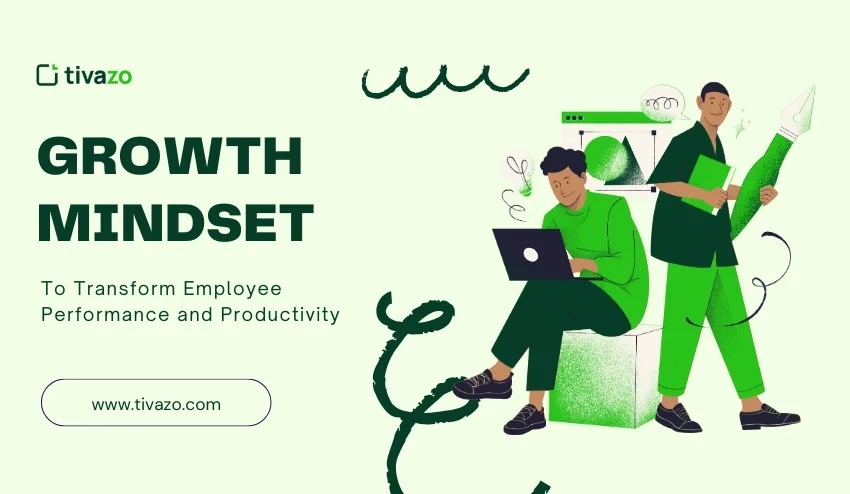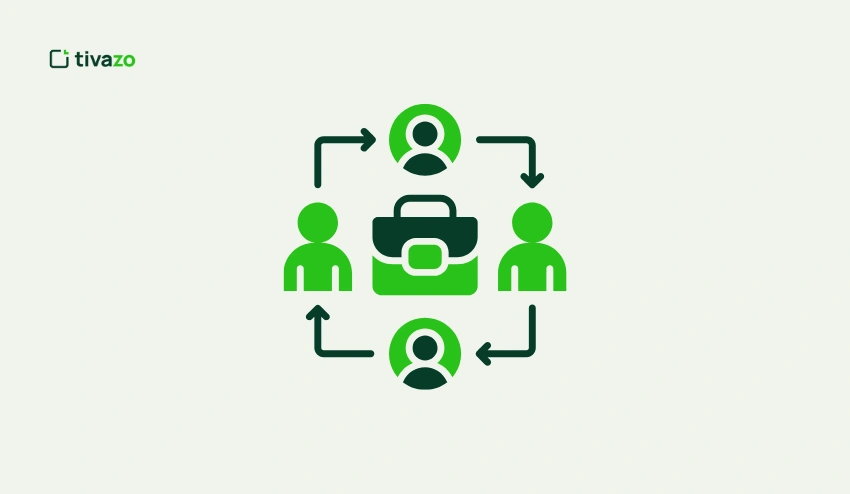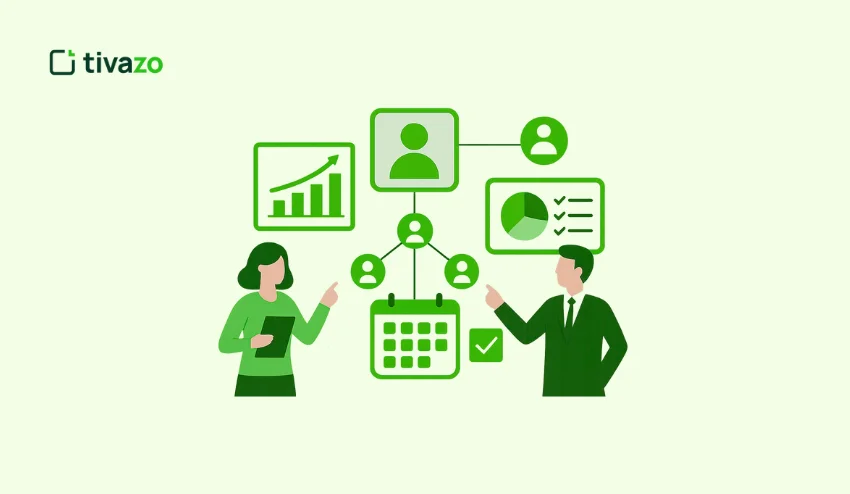In the current highly competitive business climate, organizations are sifting through different methods to enhance employee performance and productivity. While there are many options available, one of the most powerful and least utilized approaches to delivering on those outcomes is by adopting a growth mindset. Employees who possess this mindset believe that they can develop their capabilities and success through hard work. But what does it actually mean for your team’s performance, and how will it drive success in the workplace?
In this article, we will discuss the power of a growth mindset and what it can contribute to employee performance and productivity, providing you with concrete ways to cultivate a mindset culture in your organization.
Key Highlights
- What is a Growth Mindset
- Ways a Growth Mindset Drives Employee Success
- Cultivate a Growth Mindset in Your Organization
- Role of Leadership in Fostering a Growth Mindset
- Measuring the Impact of Growth Mindset
- Mistakes to Avoid When Promoting a Growth Mindset
What is a Growth Mindset?
A growth mindset means that intelligence, skills, and abilities can be advanced and nurtured over time through effort, practice, and learning. Unlike a fixed mindset, where people believe that their abilities are stationary, individuals who possess it enjoy challenges and view setbacks as an opportunity for improvement.
Why It Matters for Business
It not only positively affects individual performance but also enables firms to develop more resilient teams. Staff members with this type of mindset willingly accept challenges, recover from setbacks, and deliberately improve, all of which serve to enhance productivity, performance, and success.
5 Ways a Growth Mindset Drives Employee Success
5 Ways a Growth Mindset Drives Employee Success
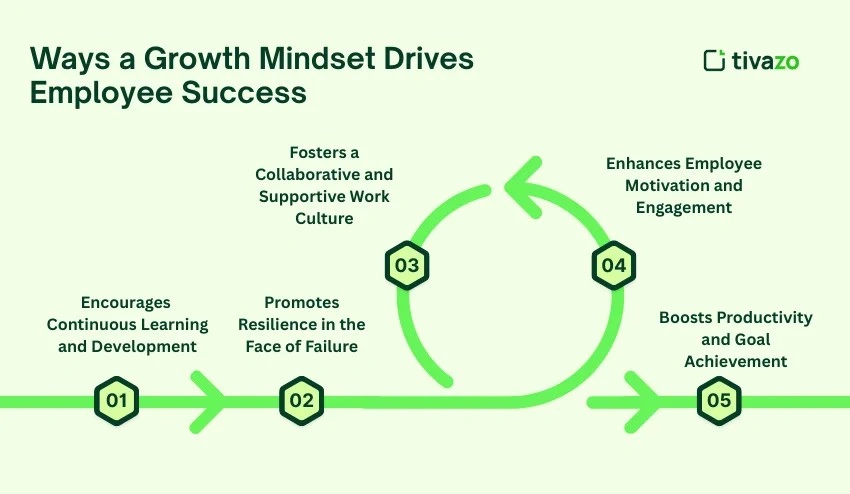
1. Encourages Continuous Learning and Development
Employees with a growth mindset constantly strive to learn new skills and improve existing ones. This drive for personal development enhances their professional capabilities, leading to higher productivity and innovation.
- Employees with a growth mindset are continuously endeavoring to learn new skills and develop existing skills.
- They actively pursue opportunities for personal growth and professional development.
- This pursuit of growth leads to higher productivity and innovation at work.
- Organizations like Google and Microsoft provide learning programs to ensure employees keep up on new skills while fostering a culture of lifelong learning.
2. Promotes Resilience in the Face of Failure
Employees with a growth mindset view failure as an opportunity for growth rather than a setback. This resilience means they are less likely to be discouraged by a challenge, reactions ultimately leads to quicker problem solving and a more resilient workforce.
- Employees view failure as a learning opportunity, rather than a setback.
- They are more likely to bounce back quickly and adapt to new challenges.
- Resilience leads to quicker problem-solving and adaptability in the workforce.
- Apple’s product failure at its early stage led to innovation later, all due to a growth mindset culture in the company.
3. Fosters a Collaborative and Supportive Work Culture
A growth mindset promotes cooperation over competitiveness. Employees with a growth mindset are willing to share knowledge, team together, and solve problems to develop a supportive, good working culture.
- A growth mindset promotes cooperation over competitiveness.
- Employees are willing to share ideas, feedback, and resources.
- Cooperation motivates teams to develop new solutions to solve problems.
- Pixar develops an open environment to share feedback within teams to modify projects seeking improvement.
4. Enhances Employee Motivation and Engagement
Employees with a growth mindset are more motivated towards taking the initiative because they see challenges as opportunities to develop personally. Therefore, they are highly motivated and engaged employees, and satisfaction with their work translates into productivity.
- Employees with a growth mindset are self-motivated and lead the initiative.
- They see challenges as opportunities for self-growth.
- This equals higher levels of job satisfaction and employee engagement.
- Zappos engages its employees by encouraging a culture of growth and autonomy, which is what drives high engagement and customer satisfaction.
5. Boosts Productivity and Goal Achievement
When staff members believe in their capabilities for growth and development, they will be more likely to set challenging goals and work toward them. Their growth mindset will yield some level of increased productivity and completion of goals.
- Growth-oriented employees will set challenging and aspirational goals and will take deliberate action in pursuit of them.
- If an employee believes they’re capable of growth and development, they will seek out and act upon excellent performance and success.
- This will lead to higher productivity and more goal accomplishment.
- Salesforce has a company culture that encourages teams to take on more difficult projects, which invariably leads to high performance.
How to Cultivate a Growth Mindset in Your Organization
There are many ways to successfully implement a growth mindset in your organization. These methods will increase performance among employees but also develop a culture of lifelong learning and innovation. Here are a few methods to consider:
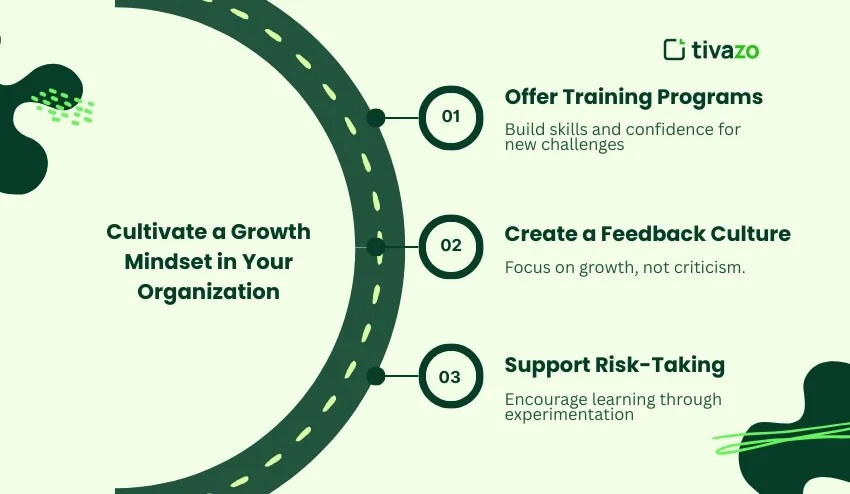
- Offer Training Programs:
- Training programs provide employees with an opportunity to develop the skills to take on challenges with confidence. These programs will develop hard skills and soft skills, such as problem-solving, resilience, and adaptability. Opportunities for growth and training allow employees to take on challenges and view failure as an opportunity for growth.
- Create a Feedback Culture:
- Creating a feedback culture is central to all forms of growth. The regular and constructive feedback process allows employees to identify areas to improve and recognize their growth. When feedback is taken positively, the focus on growth opportunities and not deficits can then help employees view feedback as an opportunity for growth and not a perception of criticism.
- Support Risk-Taking:
- Promoting a degree of risk-taking supports employees to get out of their comfort zone and try new concepts. Encouraging the mindset where failing is an opportunity to learn allows staff to explore experiments without the fear of failure. This mindset promotes experimentation as employees approach creativity and innovation differently, thereby surfacing new opportunities.
The Role of Leadership in Fostering a Growth Mindset
Leaders serve as a model in setting the tone for a culture of a growth mindset. Leaders should demonstrate openness to feedback, fail publicly, and show what they have learned and how they have grown. When they do this with everyday simplicity, it shows that continuous learning and personal development are encouraged and expected, not judged.

- Lead by Example
- Good Leaders have to demonstrate growth mindset behaviors by being open to feedback, learning from failures, and initiating challenges in front of the team. This sets the scene for employees to do the same.
- Provide Development Opportunities
- Leaders have an obligation to provide employees with options such as mentorship, training programs, and learning avenues, so they have the resources invested in their growth. This ensures employees can develop new and existing growth skills, which enhances their career both short and long term.
- Create a Safe Environment
- Leaders should foster a space of psychological safety where employees feel comfortable in risk-taking and learning from their mistakes. This consistency nurtures an environment where innovation takes place and brings about employees’ healthened on a growth mindset, avoiding the shame-fear of failure-inducing.
Integrating Growth Mindset with Corporate Strategy
To receive to full benefits of a growth mindset, it should be infused into a corporation’s overall strategy. This means putting growth mindset initiatives in the process of the key business metrics around training employees, developing employees, be they leaders, etc. It should be reported by the organization’s performance management, promotion criteria, or measures of success across the organization. Once introduced into day-to-day tasks and leadership behavioral programming.
For example, IBM incorporates the growth mindset into its corporate strategy by offering employee development programs and leadership training that foster continuous learning, problem-solving, and flexibility. This alignment ensures that the company is always prepared to grow with market demands.
Measuring the Impact of Growth Mindset on Employee Success
High levels of engagement are a direct outcome of a growth mindset, as employees become more attached to their work and deliberate about their success. Engaged employees take on challenges and display initiative because they perceive themselves as capable of growth and improvement, and find meaning in the work they do. You can quantify whether this is true by using employee surveys, focus group discussions, or engagement drug tracking tools that help assess how employees perceive their day-to-day roles or their objectives, and the levels they feel connected to the organization’s mission.

- Employee Engagement:
- Employees who have a growth mindset become more engaged, as they have a sense of purpose in their self-improvement to get involved in the organization’s mission. You can measure employee engagement through surveys when trying to understand how enthusiastic and attached employees are to the organization.
- Goal Achievement:
- Employees with a growth mentality set tougher objectives and remain consistent to conquests them. By measuring results or performance metrics, you can benchmark the total number of employees that achieved their objective or benchmark to determine the effectiveness of a culture centered around growth in the workplace.
- Retention Rates:
- Employees with growth mindsets are more likely to be retained because there are now opportunities for career advancement, skills development, or personal growth. By measuring retention, you will get a gauge of whether this type of mindset is a met or unmet client expectation or a factor contributing to sustained employee satisfaction/loyalty.
Common Mistakes to Avoid When Promoting a Growth Mindset
Promoting a growth mindset is important, but you also want to avoid certain pitfalls if you wish to cultivate a truly effective and sustainable development culture. Here are risks to avoid:
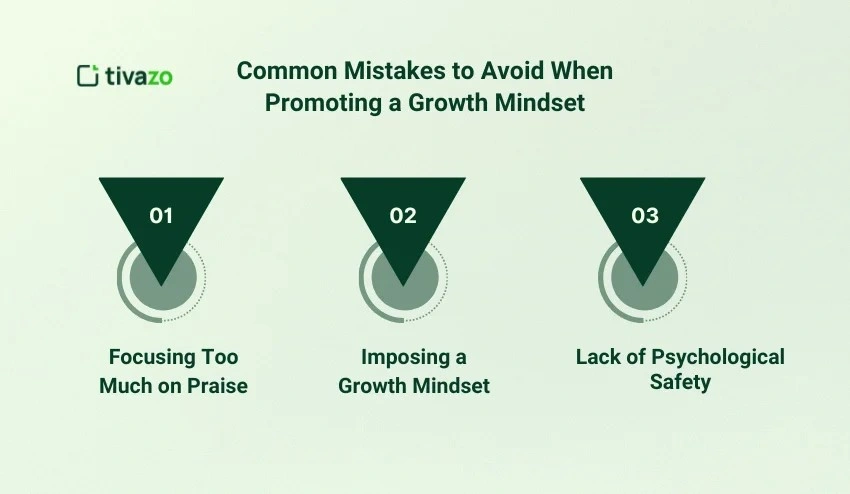
- Focusing Too Much on Praise
- While praising effort is important, it’s essential to recognize specific growth behaviors and achievements. This ensures employees understand what drives their success and encourages them to focus on tangible improvements, not just effort. Clear, actionable feedback helps reinforce desired behaviors.
- Imposing a Growth Mindset
- Employees must have the appropriate tools, training, and support to implement a growth mindset. To simply put the idea out there without giving context or resources will lead to frustration and confusion. Allow employees to be provided with the resources to make it theirs.
- Lack of Psychological Safety
- Employees must feel safe to experiment, create, fail, learn, and grow without the risk of punishment or exclusion. If psychological safety is absent, employees will refrain from risking much, impeding creativity and opportunities for growth. Employees need to feel their ideas can be reasonably shared and placed into action.
Growth Mindset in the Age of AI and Automation
As AI and automation merge, lower-skilled workers in many industries are faced with the challenge of staying competitive and relevant in the modern workforce. The rapid increase of technology will require employees to be more open to continuous learning and adapting to new roles and changing tasks. Where a growth mindset comes into play is the utilization of AI co-pilot tools or other tech that can provide timely and specific feedback. AI and technology can assist employees with personalized learning paths and tracking skill development to build competencies more effectively. Artificial Intelligence can help employees work on themselves as they contemplate “future-proofing” their careers.
Conclusion
Bringing growth mindset into your workplace can improve employee performance and productivity. This is important for organizational performance, so creating a culture of learning, resilience, and collaboration is critical. The strategies in this post can help unleash the full potential of your employees while significantly improving environment performance, as well as engagement with both their own and team’s performance.
Get started today invest in helping your employees grow their growth mindset while you watch your organization prosper.
